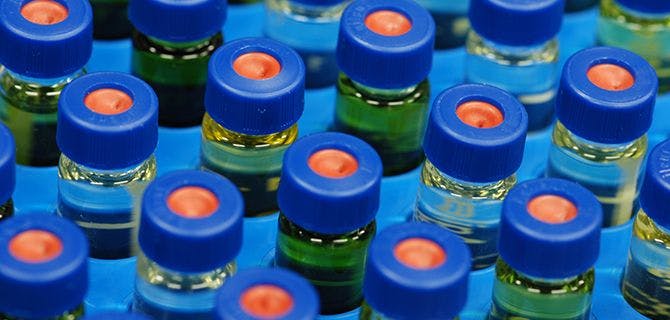American Chemical Society (ACS) Reagent Chemical Committee member Dr. Robert J. Thomas has worked in the field of trace element analysis for more than 40 years. For the past 17 years, Thomas has been the leader of the plasma spectrochemistry task force, working closely with the United States Pharmacopeia (USP) to align heavy metal testing […]


American Chemical Society (ACS) Reagent Chemical Committee member Dr. Robert J. Thomas has worked in the field of trace element analysis for more than 40 years. For the past 17 years, Thomas has been the leader of the plasma spectrochemistry task force, working closely with the United States Pharmacopeia (USP) to align heavy metal testing procedures in reagent chemicals with those of pharmaceutical materials. He has authored almost 100 publications on the fundamental principles and applications of plasma spectrochemistry and sample preparation techniques. He has also written three textbooks on trace element analysis, including a new book, which focuses on the new global directives for elemental impurities in pharmaceutical materials. He is currently editor and frequent contributor to the Atomic Perspectives Column in Spectroscopy Magazine. He has an advanced degree in analytical chemistry from the University of Wales in the U.K. and is a Fellow of the Royal Society of Chemistry, and a Chartered Chemist.
In this interview, Thomas explains how this work has been incorporated into important updates recently made to ACS Reagent Chemicals.
Can you explain the recent changes in heavy metals testing?
One of the most significant new methods now implemented in ACS Reagent Chemicals is heavy metal testing, and more specifically, the replacement of the old sulfide precipitation colorimetric method. This test is very similar to the 100-year-old USP method for heavy metals testing in pharmaceutical materials, which is a colorimetric test based on precipitation of the metal sulfide in a sample, and comparing it to a lead standard. The USP method is being replaced by two new chapters: Chapter 232, which defines the elemental impurity limits and Chapter 233, which describes the plasma-based analytical techniques, sample preparation procedures, and validation protocols to meet those limits. The ACS Committee on Reagent Chemicals had many discussions with USP personnel during the drafting and writing of new plasma-based methods in order to align our new spectrochemical methodology for elemental impurities with theirs.
Why do you think it is so important that these changes are made?
The process of updating procedures and setting new specifications is a time-consuming process and can sometimes take years to complete. By carrying out various testing protocols including sample preparation and spike recovery procedures, it ensures that new methods are rugged, robust and will stand up to scrutiny, wherever ACS Reagent Chemicals is used around the world. Many standards organizations and federal agencies that set guidelines, specifications, and/or analytical testing methods—including the United States Pharmacopeia and the U.S. Environmental Protection Agency, require the use of ACS grade reagent chemicals in many of their test procedures. For that reason, it has become the “de facto” reference book worldwide for the chemicals used in high-purity laboratory applications. One of the major new components of the book is the focus on the new plasma spectrochemical-based methodology for carrying out the determination of a suite of heavy metals in reagent chemicals.

Can you provide a historical perspective on the heavy metals test?
Colorimetric analytical methods have been used in analytical chemistry for over 100 years and are based on measuring color changes of solutions that arise from specific chemical interactions with the analyte elements. The traditional colorimetric test for heavy metals in chemical reagents or pharmaceutical matrices is based on a chemical reaction of the heavy metal with a sulfide solution, and compared with a standard prepared from a stock lead solution. It relies on the ability of heavy elements such as lead, mercury, bismuth, arsenic, antimony, tin, cadmium, silver, copper, and molybdenum to react with the sulfide at a pH of 3-4 to produce a precipitate of the metallic sulfide that is then compared with a lead standard solution. It is used to demonstrate that the metallic impurities colored by sulfide ions under the specific test conditions do not exceed a pre-defined limit.
One of the many drawbacks of this approach is the assumption that the formation of the sulfides in the sample is very similar to the formation of the lead standard solution and is not affected by the sample matrix. However, since many metals behave very differently, the method requires that the visual comparison is performed very quickly after the precipitate has formed. Unfortunately, analysts can differ in their interpretation of the color change, so different analysts may not consistently read the sample and standard solutions correctly each time.
For all these reasons, the 11th edition of the book has started the process of replacing the sulfide precipitation test for heavy metals in a number of reagent chemicals with inductively coupled plasma – optical emission spectrometry (ICP-OES). The first suite will include those chemicals where the maximum allowable concentrations are at an appropriate level for the technique and where the spectral and matrix-induced interferences are well-understood and easily compensated. In addition, the committee has started the process of validating inductively coupled plasma mass spectrometry for the analysis of ultra-trace reagents and acids where ICP-OES is not suitable based on its inferior detection capability. However, it is important to emphasize that the use of older, more traditional techniques will still be allowed, as long as the analytical procedure can be fully validated, because, in many parts of the world, modern analytical techniques are either not available, or can be extremely cost-prohibitive to purchase.